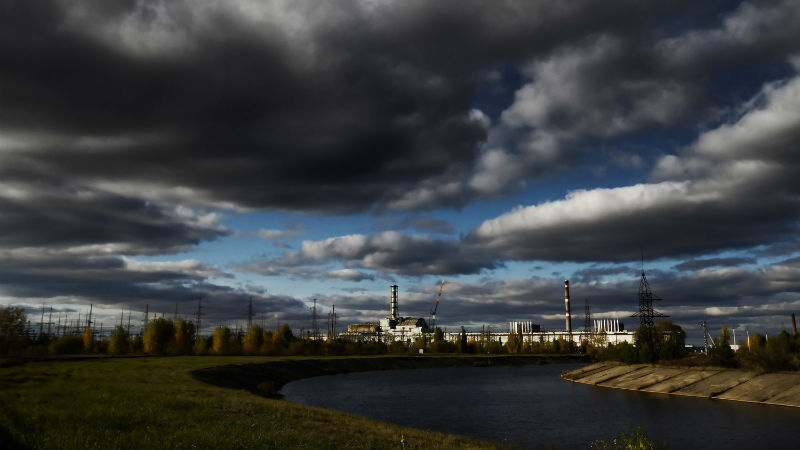
Chernobyl reactor #4 seen from across the man-made cooling river, Ukraine, in 2013. Image by Guy Corbishley from Demotix.
As Russia recovers from massive wildfires in the Siberian regions of Khakassia and Zabaikal, Ukraine has encountered an even more alarming problem: a 400-hectare wildfire dangerously close to the Chernobyl exclusion zone.
Ukrainian officials have said that Reactor Four, which failed during the 1986 Chernobyl disaster, is not in danger from the wildfire. Still, Ukraine has mobilized firefighters, the National Guard, and head officials to the affected area to prevent a potential crisis. Prime Minister Arseniy Yatsenyuk, who arrived at the scene of the fire on April 28, has said that even though the situation is “under control,” it is the largest wildfire near Chernobyl since a massive 1992 blaze.
The Ukrainian Minister of Interior Affairs, Arsen Avakov, initially announced the situation on his Facebook page on the evening of April 28, when strong winds were making it likely the fire could spread to the 20 km (12.5 mile) exclusion zone around Chernobyl.
Работаем. Понимаем ответственность и не допустим недооценки рисков!
We're working. We understand the responsibility and we won't allow risks to be underestimated!
As in the case with the wildfires in Russia, social media has already emerged as a vital tool in distributing information to local residents regarding the status of the wildfire. Along with Minister Avakov, the Ukrainian head of the State Service of Emergency Situations, Zoryan Shkiryak, has been providing regular updates on the wildfire on Facebook, detailing the response to and the extent of the blaze.
However, much as Greenpeace had criticized the Russian response to the Siberian wildfires, the environmental organization has cited different figures on the Chernobyl wildfire from those released by Ukrainian officials. Soon after statements from Avakov and Shkiryak putting the size of the wildfire at 4,000 hectares or fewer, Greenpeace put the blaze at 10,000 hectares.
Reactions From Nearby
Many in Ukraine’s capital of Kyiv, which lies about 100 km (62 miles) south of Chernobyl, have expressed concerns regarding the fire online. A poll on the popular “Typical Kyiv” (Типичный Киев) VK group asked users if they could smell the smoke from the wildfire, garnering about 4000 responses (only 20% said yes).
Though it is unlikely than the smoke these 20% were smelling was smoke from the wildfire, another popular post in the group offering tips for dealing with radiation demonstrated the anxiety that still looms over Ukraine a generation after the Chernobyl disaster. But radiation levels in the capital remained within norm, as journalist Sergiy Karazy demonstrated in a FB post:

Сьогодні можна проводити експрес IQ тест в українському сегменті ФБ. Всі хто серйозно обговорює необхідність заклеювати вікна, не виходити на вулицю і пити йод, його безнадійно провалили.
На фото – рівень Гамма-потужності в центрі Києва 0.09 од. при допустимому максимумі в 0.30.
Today you could do an express IQ test in the Ukrainian Fb segment. All of those who are seriously discussing taping up windows, staying inside and drink iodine, have failed this test hopelessly.
The photo shows the level of gamma radiation in downtown Kyiv at 0.09 μSv/h with an acceptable maximum of 0.30 μSv/h.
Reactions From Further Away
While the online reaction in Kyiv was one of panicked concern, the response from separatist-held eastern Ukraine was slightly more bizarre. According to a conspiracy theory from one pro-separatist news website, the Ukrainian government may have started the wildfire as a “provokatsiya” (provocation, roughly equating to a “false flag”) in order to extract financial assistance from the European Union, representatives of which had recently visited Kyiv.
Примечательно, что пожар вспыхнул как раз во время проведения в Киеве саммита «Украина-ЕС». Учитывая, насколько Евросоюз озабочен безопасностью объектов, подобных Чернобыльской АЭС, и в этой связи на протяжении нескольких десятилетий выделяет немалые средства на предотвращение техногенных катастроф, то исключать вероятность провокации со стороны киевской хунты нельзя.
It's worth noting that the fire erupted during the exact time the “Ukraine-EU” summit was happening in Kyiv. Knowing how concerned the EU is with the safety of objects like the Chernobyl power station, and how it has been giving sizable amounts of money for decades to prevent tehcnogenic catastrophes, we can't exclude the possibility of a provocation from the Kyiv junta.
Though it seems implausible that Ukrainian officials plotted a fire near the site of a nuclear disaster only to provide by-the-minute social media updates on firefighting later, Minister Avakov has indicated via his Facebook that arson could be a likely cause of the fire.
As of the morning of Wednesday, April 29, emergency officials said the fire was contained, with over 300 people and 50 vehicles working to extinguish the remaining blazes in an area narrowed down to 270 hectares. Whatever the facts, both the panic and the conspiracy theories will likely smolder for a while. As Ukrainian emergency responders fight to prevent a further disaster in Chernobyl, the information war seems to burn as hot as ever.








1 comment